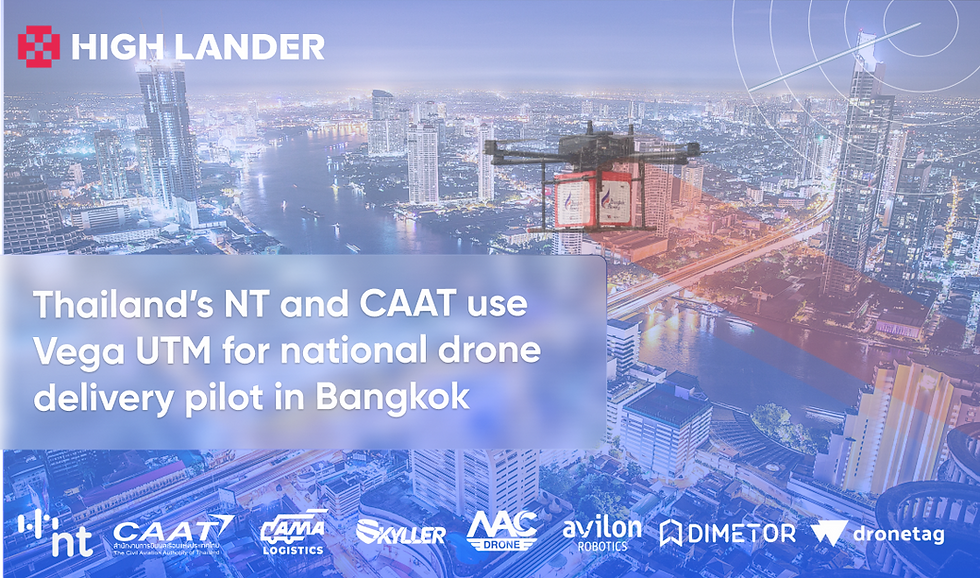Alon Abelson interviewed by the Global UTM Association
- Simon Golstein
- Jun 13, 2023
- 3 min read

What is High Lander and what is its role and involvement within GUTMA?
High Lander is a provider of drone fleet management and UTM platforms, fielding two drone-agnostic, next-generation solutions that are in use by clients and governmental authorities around the world. Our vision is building the infrastructure necessary to support the new generation of uncrewed air traffic. To this end, we designed our UTM solution, Universal UTM, to be capable of coordinating inter-drone traffic and enabling this traffic to operate alongside traditional aviation. This is the future - full airspace coverage achieved by integrating UTM systems with traditional ATM services.
“As aviation evolves, it becomes imperative for conventional ATM services to incorporate UTM solutions in order to ensure comprehensive airspace coverage and maintain their unparalleled safety record. Fortunately, technology that enables seamless integration is already available.”
We’re very proud to join GUTMA because we share the value that the world is in urgent need of a U-space, and that a universal standard in UTM services is a prerequisite to this happening. We believe that Universal UTM helps define that standard. It’s an autonomous solution that coordinates flight plans, giving approvals and denials as needed, and provides real-time traffic monitoring that enables it to enact tactical deconfliction whether the conflicts are between drones, between drones and crewed aircraft, or between drones and NFZs.
According to you, what are the biggest industry challenges at the moment?
I wouldn’t put one challenge above any other in importance - in aviation, everything needs to work well. However, coming from the world of traditional air traffic control (I served in the military in this capacity for many years), I can say that integration with traditional ATM services is vital. Traditional ATM systems aren’t built to pick up large numbers of low-altitude aerial vehicles, and many airports employ independent teams whose focus is tracking these threats. We envisage a world where drones aren’t seen as threats, and this can only happen when ATM and UTM services work in tandem. At the same time, we understand why ATM providers see drones as threats - traditional air traffic control is a remarkable achievement which over the last 100 years has achieved a safety record that’s second to none. However, the status quo has already changed, and the ATM industry has to adapt along with it in order to maintain its impressive safety statistics. Part of the challenge of UTM providers is convincing the ATM industry that this is not a revolution, but an evolution - for example, technologies like Remote-ID, which are already active and due to become universal in Europe and the US very shortly, provide the same level of detection and transparency as ADS-B technology does in traditional aircraft. We’re proud to say that Universal UTM has made significant inroads in this direction. For example, as part of the Israel National Drone Initiative, our solution was integrated into the Israeli Air Force’s Northern Command station. The test ran for a week and was highly successful. Following this, we entered integration talks with Saipher, the company that supplies ATM services to airfields throughout Brazil. We’re excited to see the future take shape.
A word about the need to be working along the full ecosystem/value-chain?
There is already a multiplicity of drone technology suppliers, and we can expect this to grow. I think that in the future, suppliers won’t get far if they close themselves to integrations with other suppliers. For example, it won’t be long until air taxis are a staple of modern life - the technology exists, and who would want to be stuck in traffic if they can fly? - but this requires providers and UTM services to be able to communicate, regardless of supplier/operator/manufacturer. Apart from the safety aspects, we can’t expect regulators to sign off on these services until this is standard. Air taxis aside, we see drones taking a role in every part of the world economy. And just like the economy today, things only work when everyone works together.
About Alon Abelson
Alon Abelson is the co-founder and CEO of High Lander. He served for more than twenty years as a military air traffic controller, achieving the rank of Major, and authority over all airports in Israel’s northern region. In his civilian life, Alon holds a BA in economics and has more than a decade of C-level experience in the B2B software sector. High Lander is the result of all these experiences: he has a special perspective on the growing presence of drones and what they can do, the technical expertise to engineer solutions, and the business experience to create a team capable of making it happen. Alon created the company with co-founder Ido Yahalomi to provide solutions covering every aspect of the new era of aviation.



Comments